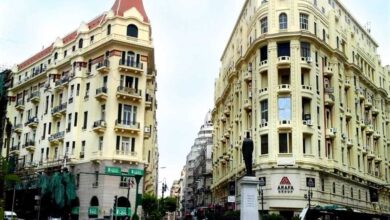When the headquarters of the National Democratic Party (NDP) were set ablaze in the early days of anti-government protests in Tahrir Square, the event was seen as symbolic of the collapse of the old order.
Now, as if a metaphor for the country as a whole, the building has an uncertain future.
The Cairo city government has its own vision of what should become of the site, while pro-revolutionary groups have other ideas.
"We just need to keep the building, black and burned, like it is," says Mohamed Adel, spokesman for the 6 April Youth Movement, a member of the youth coalition in dialogue with the government over the building’s future.
For the time being, he says, the sight of the gutted office block best serves as a reminder of the protesters’ struggle. Its destroyed face could be a monument to the revolution, much like the remnants of the Berlin Wall in Germany.
"In a lot of countries, there are buildings that are kept to remind them that there was a war," Adel says.
In the future, he said, 6 April would support a museum for the revolution’s martyrs on the site.
Government officials, however, have less idealistic plans. Cairo governor Abdel Azeem Wazeer announced in February that engineers had examined the building and deemed it damaged beyond repair. The area might be turned into a public garden, he says.
Wazeer has also announced the formation of a committee that will determine how to renovate Tahrir Square and the surrounding land. The committee is holding a contest, and will devise a plan based on ideas submitted by citizens.
"If we don't have a committee of specialists, we might have a memorial from the 6 April movement, a memorial from Kifaya, from all the groups," says Cairo Governorate Spokesman Khalid Mustafa Mohamed. "And one might be distasteful."
He says it would be better if the site were used by the public, with sports fields and green areas, rather than preserved in its current blackened state.
Though the Egyptian National Museum, on an adjacent lot, has also made some claims to the land, he says it has historically belonged to Cairo Governorate; in which case, the governor is responsible for the development plans. A park, he says, could be used by both tourists and museum visitors.
The National Democratic Front Party, part of the youth coalition, supports the Cairo governor's plans.
"We feel we should have a garden in this place, where there will be a memorial to the martyrs of the revolution," says Shehab Wagih, a member of the executive board of the party.
The burning of the NDP building on 28 January was one of the most prominent acts of destruction carried out by anti-government protesters during the revolution, although many other government and police buildings were targeted throughout the country. The circumstances under which the fire started remain unclear.
For many Egyptians, seeing smoke rising from the NDP headquarters was evidence that the Mubarak’s regime had lost control and that the end of his rule was near. The building could be seen smoldering for several days, worrying some that it would collapse onto the National Museum.
During and after the revolution, protesters and families took pictures in front of the building, many expressing disbelief at the sight.
Any construction in the area will likely not begin for months, as the committee is just now welcoming submissions, according to committee members.
One area of agreement with the 6 April Youth Movement is that there are more important things to be accomplished before any projects can take place on the site. Adel says the group is more focused on changing laws in the country, and in particular with raising the national minimum wage.
Zaina Abdel Nabi, a petroleum company employee, and her daughter Nour Khamis, a university student, have traveled from Alexandria to see the remains of the party headquarters. They stand in front of the gates, snapping pictures with a cell-phone.
"We want the name of the National Democratic Party erased from everything," she says. "And the trial of Hosni and Suzanne Mubarak."
Al-Nabi says she supports the governorate's plan to make the building into a garden dedicated to the martyrs and hopes it will become a place her children can enjoy.
"After all, it's her revolution," she says, pointing to her daughter. "In the future, we have to use this place."




